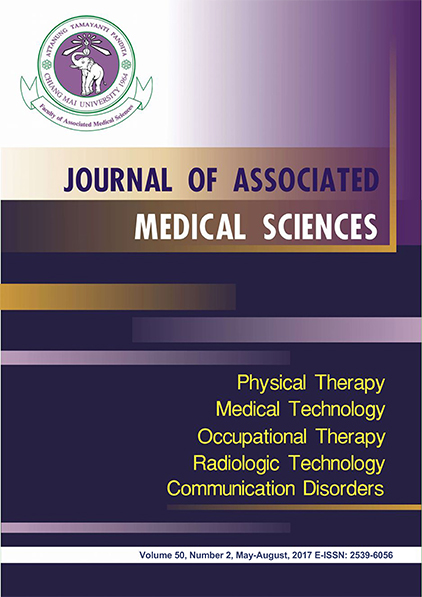Acetylcholinesterase and butyrylcholinesterase levels of healthy volunteers who not exposed to pesticides in Chiang Mai Province
Main Article Content
Abstract
Background: Food contamination of pesticides, especially organophosphate and carbamate, leads to changes in cholinesterase level. Thus, using of previous reference value of enzymes to predict the severity of pesticides exposure may be misleading.
Objectives: To evaluate the recent reference intervals of acetylcholinesterase (AChE) and butyrylcholinesterase (BChE) of healthy volunteers who did not expose to pesticides in Chiang Mai Province.
Materials and methods: Three hundred and forty blood samples were collected from healthy volunteers attended in blood donation at Nakornping Hospital, Chiang Mai. The participants did not exposure to pesticides. Level of red blood cell AChE and serum BChE were determined based on spectrophotometric assay. Reference interval was calculated and presented as arithmetic mean±SD.
Results: Levels of red blood cell AChE and serum BChE from male healthy volunteers were not statistically different from those of female. Reference interval of red blood cell AChE and serum BChE are 5,136±1,452 U/L (3,684-6,588 U/L) and 3,164±1,264 U/L (1,900-4,428 U/L), respectively.
Conclusion: From this study, reference interval of red blood cell AChE and serum BChE can be used for diagnosis of organophosphate and carbamate intoxication in forensic laboratory.
Journal of Associated Medical Sciences 2017; 50(2): 168-175. Doi: 10.14456/jams.2017.16
Article Details

This work is licensed under a Creative Commons Attribution-NonCommercial-NoDerivatives 4.0 International License.
Personal views expressed by the contributors in their articles are not necessarily those of the Journal of Associated Medical Sciences, Faculty of Associated Medical Sciences, Chiang Mai University.
References
2. ปริมาณและมูลค่าการนำเข้าสารกำจัดศัตรูพืช [Internet]. ประเทศไทย: สำนักงานเศรษฐกิจการเกษตร. C2016. [updated 2016 June 8; cited 2017 Jan 15]. Available from: http://www.oae.go.th/ewt_news.php?nid=146
3. Lionetto MG, Caricato R, Calisi A, Giordano ME, Schettino T. Acetylcholinesterase as a Biomarker in Environmental and Occupational Medicine New Insights and Future Perspectives. BioMed Res. Int. 2013; 2013: 321213.
4. Čolović MB, Krstić DZ, Lazarević-Pašti TD, Bondžić AM, Vasić VM. Acetylcholinesterase Inhibitors: Pharmacology and Toxicology. Curr Neuropharmacol. 2013 May; 11(3): 315–35.
5. Lockridge O. Review of human butyrylcholinesterase structure, function, genetic variants, history of use in the clinic, and potential therapeutic uses. Pharmacol. Ther. 2015; 148: 34-46.
6. Bryson PD. Comprehensive Reviews in Toxicology: For Emergency Clinicians. 3rd ed. Washington, DC: Taylor & Francis; 1996.
7. Kala M. Pesticides. In: Moffat AC., Osselton MD., Widdop B. editors. Clarke’s Analysis of Drugs and Poisons. 3rd ed. London, UK: Pharmaceutical Press; 2004: 202-38.
8. Thomsen T, Kewitz H, Pleul O. Estimation of cholinesterase activity (EC 3.1.1.7; 3.1.1.8) in undiluted plasma and erythrocytes as a tool for measuring in vivo effects of reversible inhibitors. J Clin Chem Clin Biochem. 1988; 26(7): 469-75.
9. คณะแพทยศาสตร์ศิริราชพยาบาล มหาวิทยาลัยมหิดล. คู่มือการส่งตรวจทางห้องปฏิบัติการทางการแพทย์ 2559 [19 May]. Available from: https://www.si.mahidol.ac.th/th/manual/document/a07/cholinesterase%20serum.htm.
10. ภัทรวดี พงษระวีวงศาและวีระวรรณ เรืองยุทธิการณ์. การวัดระดับเอนไซม์โคลีนเอสเทอเรสในซีรั่มของคนไทยปกติ. เชียงใหม่เวชสาร. 2543; 39(1-2): 21-9.
11. Çokuğraş AN. Butyrylcholinesterase: Structure and Physiological Importance. Turk J Biochem] 2003; 28 (2): 54-61.
12. Bailey DN, Briggs JR. Studies of the Inhibition of Serum Pseudocholinesterase Activity In Vitro by Commonly Used Drugs. Am J Clin Pathol. 2005; 124(2): 226-8.
13. Lee PE, Hsiung GYR, Seitz D., Gill SS., Rochon PA. Cholinesterase inhibitors. BCMJ. 2011; 53(8): 404-8.
14. Henderson MPA, Cotton SW, Rogers MW, Willis MS, McCudden CR. Method Evaluation. In: Bishop ML., Fody EP, Schoeff LE. Editors. Clinical Chemistry: Principles, Techniques, and Correlations. 7th ed. Philadelphia, USA. Lippincott Williams & Wilkins, 2013. 52-89.


